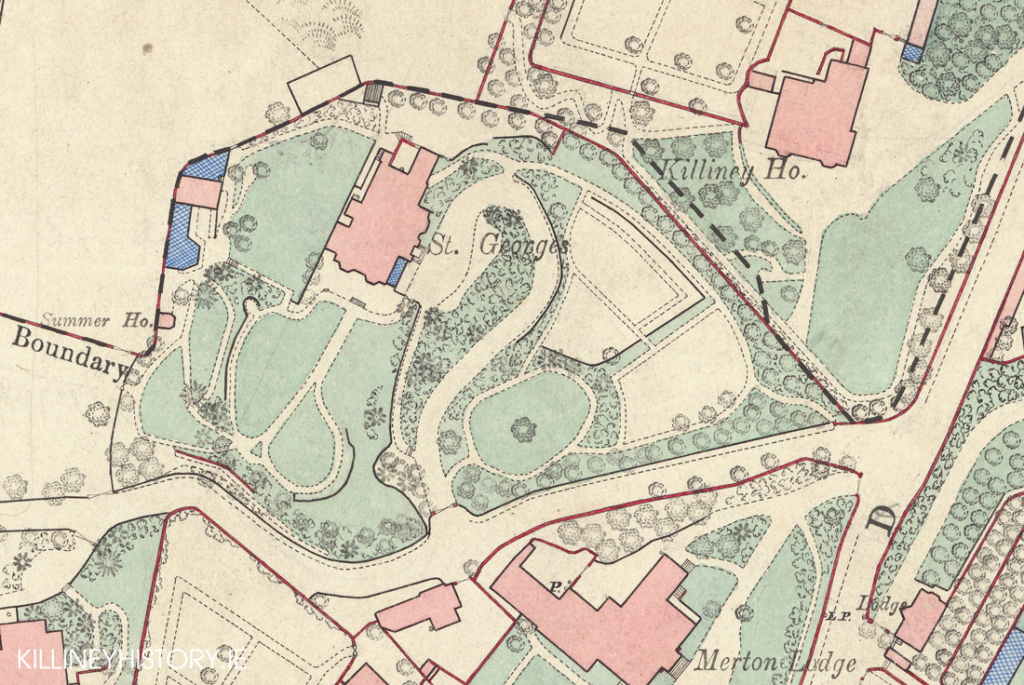Description by Peter Pearson
Peter Pearson ‘Between the Mountains and the Sea‘ (1998), p. 74
St. George’s was designed and built by George Ashlin, the noted architect. His wife was the daughter of Augustus Welby Pugin, a devoted admirer of the Gothic. It is no surprise that St George’s, built in 1882, is something of a Victorian Gothic extravaganza, built in red brick with its steep and varied tiled roofs, conical tower, Gothic fireplaces and a small, panelled chapel. The walls were once decorated with William Morris wallpapers. There is still a remarkable collection of stained glass, executed by Edward Frampton, to be seen throughout the house. The windows represent the architect and his wife in prayer, as well as St George, St Dorothea and various subjects such as music, poetry, architecture and painting. There is also an excellent stone carving of St George and the dragon over the front door. The staircase landing is ornamented with corbels which are painted with coats of arms.
1888 Ordnance Survey Map

Description by John O’Sullivan
Extract from The Book of Dun Laoghaire (1987), p. 57
St. George’s is a large red brick detached house with a fine turret type tower in one corner. It was built about 1880 by George Ashlin, the famous ecclesiastical architect. With its purpose-built Gothic furniture and frescoed walls (painted over by a later occupant Norman Judd) its interior looked like a 19th century church. Mrs. Ashlin was the granddaughter of A. W. Pugin the famous English architect who designed the House of Commons in London. She designed the stained glass windows in the oratory at St. George’s. Ashlin built Carrigrennane, further up St. George’s Avenue, for his son. The redbrick Tudor Gothic-style gate lodge, now Kilda Lodge, with its date 1882 set in mosaic was the studio in the 1920s of the sculptress Mia Cranwill.
Listings from Thom’s Directory
| 1887-1923 | Ashlin, George C. R.H.A. |
| 1924-1937 | Ashlin, Stephen M. |
| 1940-1980 | Judd, Norman |
| 1986 | King, Desmond |
George Coppinger Ashlin 1837-1921
Extract from Dictionary of Irish Architects

George Coppinger Ashlin was born at Carrigrenane House, Co. Cork, on 28 May 1837. In 1856 he became a pupil of EDWARD WELBY PUGIN , first in Birmingham and then in London, and from 1858 until 1860 he was also a student at the Royal Academy. On completing his articles, he was taken into partnership by Pugin, who gave him the responsibility of establishing a Dublin branch of the practice and taking charge of the Irish commissions, which now included the large new church of SS Peter and Paul in Cork. Each day he would catch a fast train from Killiney to Westland Row and walk from the station to his office at 7 Dawson Street. On reaching the office door he would hand his umbrella and attaché case to an awaiting junior member of staff and mount the horse which a man held ready at the kerb. He would then canter up Dawson Street to to Stephen’s Green and ride several times round the park on the track which ran just inside the railings before returning to the office to start his day’s work. According to his obituarist in the RIAI Journal, Ashlin ‘continued in active energy until a short while before his death’ and ‘preserved his comparatively youthful bearing almost to the end of his active career’. He died, aged eighty-four, on 10 December 1921, at St George’s, Killiney, the house which he had designed for himself, and was buried in the family plot in Glasnevin Cemetery.
Norman Judd 1904-1980
Frederick Norman (Norman) Judd born 6 April 1904 at Strawberry Hill, Dalkey. Norman represented Ireland at water polo at the Olympics in 1924 and 1928. He took over the running of Judd Bros in Hardwicke Street. The factory was one of buildings razed to the ground during a spate of fires in Dublin in 1962.